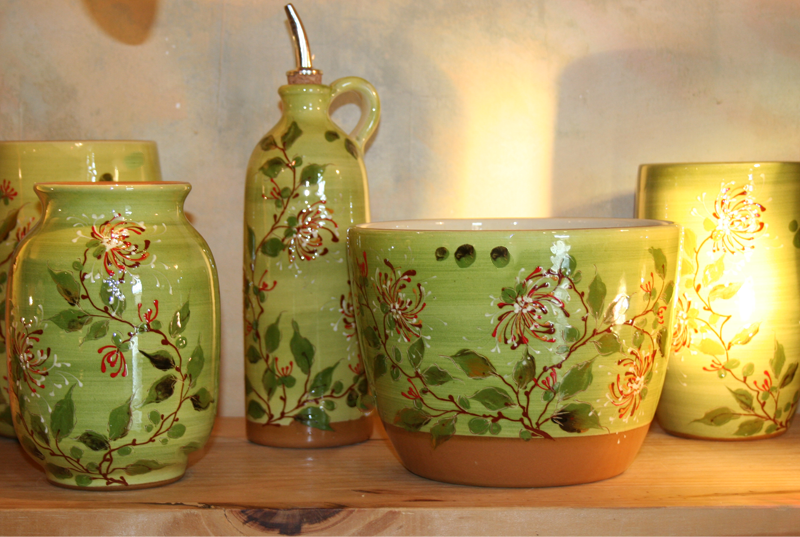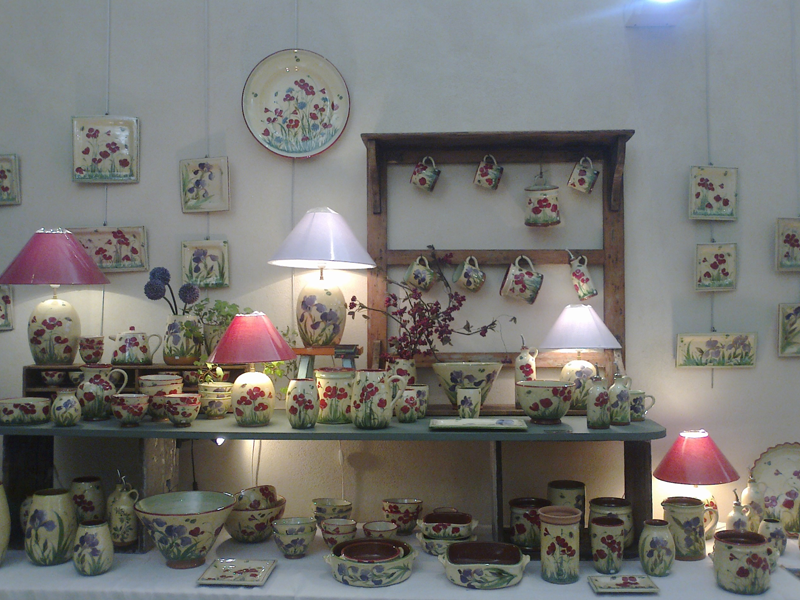In 1966, Georgina, my mother made his first attempts at decoration on earthenware Fox Amphoux (Var) where my father is a teacher. It performs traditional decorations on baked enamel Moustiers (a technique called "low heat" in the Workshop Carle Barjols (Var).
In 1967 Michael Fine, my uncle moved to Fox Amphoux. He initiates himself to decoration. He opened a boutique for decoration at the center of the old village.
Alain and his wife Vagh Jacotte, manufacturers of floor tiles at Salernes (Var), ordered to Georgina in 1969, a series of 50 plates based on a project from Ronald Searl, English cartoonist.
The shop at Fox Amphoux was closed in 1974 whereas my brother Vania and I we were learning decoration. We then opened a shop at Bauduen near the lake of Sainte Croix du Verdon.
Unable to obtain the electric power needed to supply a kiln, we decided to make our own cookie and we left Bauduen in 1976 to move to Moustiers Sainte Marie (city of faience) in Alpes de Haute Provence, with the help of Mr Jean Hubert, merchant in the village.
My brother Vania joined us the following year and became the turner, my mother and my uncle became the designers, and myself was the enamel stamper and in charge of the cooking. Then followed Isabelle, the wife of my brother, and my own wife Muriel. Patrica Guillon became our apprentice and stayed with us nearly 10 years.
In 1978 my uncle Jean Louis Michel, joined the beautiful family-run workshop and the pieces were signed J.M.V. Moustiers Fine.
In 1978 Roland Delcol, hyper-realistic belgian painter proposed to perform himself the scene of a series of pieces that are now available in our gallery at Moustiers like Picasso in Paris with Madura. Fruitful collaboration lasted four years.
Other artists have been invited by the workshop, to express themselves freely on faience : Yves Nioré, Michel Richard, Carroll Bertin, Jean Charasse, Soft-Sillas Marceau, Catherine Viollet, Jean Jacques Ceccarelli, Andrew Lauro, Beppo, Bernard Morteyrol, Franta, Xenakis, without forgetting Georgina, Michel and Denys Fine.
In 1988 all these contributions were gathered in a "Tribute to Picasso" with the works of 27 artists which initiated several exhibitions from Moustiers to Bitche in Lorraine through Marseille, Toulon, Leinfelden (Germany) , Montellupo Florentini (Italy) and Martigny, -Gianadda Foundation (Switzerland).
A book published in 2008, by the association "Free Entry" entitled "Fine JMV: Faience workshop at the end of the twentieth century" tells in detail the story of the workshop.
En 1966, Georgina, ma mčre, fait ses premiers essais de décoration sur faience ŕ Fox-Amphoux (Var) oů mon pčre est instituteur. Elle exécute des décors traditionnels de Moustiers sur émail cuit (technique dite "ŕ petit feu" pour l'atelier Carle de Barjols dans le Var.
En 1967 Michel Fine, mon oncle, s'installe ŕ Fox-Amphoux. Il s'initie ŕ son tour ŕ la décoration. Il ouvrira une boutique-atelier de décoration place du vieux village.
Alain Vagh et sa femme Jacotte, fabricants de tommettes ŕ Salernes (Var) commandent en 1969 ŕ Georgina, une série de 50 assiettes ŕ partir d'un projet de Ronald Searl, dessinateur et caricaturiste anglais.
La boutique de Fox-Amphoux ferme en 1974 ŕ l'époque, oů mon frčre Vania et moi, nous nous initions aussi ŕ la décoration. Nous ouvrons alors une boutique ŕ Bauduen au bord du lac de Sainte Croix du Verdon (mis en eau en 1972).
Ne pouvant obtenir la puissance électrique nécessaire ŕ l'alimentation d'un four ŕ céramique, car nous avions décidé de fabriquer notre propre biscuit, nous quittons Bauduen en 1976 pour Moustiers Sainte Marie (cité de la Faince) dans les Alpes de Haute Provence par l'intermédiaire de Mr Jean Hubert, marchand de faience dans le village.
Mon frčre Vania nous rejoint l'année suivante: il sera le tourneur de l'atelier. ma mčre et mon oncle en seront les décorateurs; je serai l'estampeur émailleur et m'occuperai des cuissons. Suivront Isabelle, l'épouse de mon frčre ainsi que Muriel ma propre épouse. Patrica Guillon deviendra notre apprentie et restera avec nous prčs de dix années.
En 1978 mon oncle Jean Louis, jumeau de Michel, viendra compléter l'atelier familal. Les pičces seront signées J.M.V. Fine ŕ Moustiers.
En 1978 Roland Delcol, peintre hyper-réaliste belge, nous proposera d'exécuter lui męme le décor d'une série de pičces qui seront proposées dans notre galerie de Moustiers comme le fit Picasso chez Madura ŕ Paris. S'ensuivit une fructueuse collaboration qui se perpetua pendant quatre ans.
D'autres artistes seront invités, par l'atelier, ŕ s'exprimer librement sur sa faience: Yves Nioré, Michel Richard, Caroll Bertin, Jean Charasse, Marceau Doux-Sillas, Catherine Viollet, Jean Jacques Ceccarelli, André Lauro, Beppo, Bernard Morteyrol, Franta, Xénakis, sans oublier Georgina, Michel mon oncle, et Denys Fine, mon pčre.
En 1988 cette suite de rencontres et de travail partagé débouchera sur un "Hommage ŕ Picasso" qui réunira les oeuvres de 27 artistes et donnera lieu ŕ des expositions de Moustiers ŕ Bitche en Lorraine en passant par Marseille, Toulon jusqu'en Allemagne (Leinfelden), en Italie (Montellupo Florentini) et en Suisse (Martigny, fondation Gianadda).
Un livre paru en 2008 édité par l'association "Entrée Libre" intitulé "J.M.V. Fine: un atelier de faience ŕ la fin du XXe sičcle" relate en détail l'histoire de l'atelier.

Fabrication terre vernissée
Nous utilisons des argiles naturelles. Toutes nos pičces sont façonnées ŕ la main, tournage et estampage.
Tournage : Réalisation d'une pičce ŕ l'aide d'un tour ŕ partir d'une boule de terre.
Estampage : Réalisation d'une galette de terre d'épaisseur définie que l'on va appliquer sur un moule afin de lui donner sa forme.
Les pičces réalisées sont ensuites engobées, c'est ŕ dire recouvertes d'une couche de terre blanc liquide apposée ŕ la louche ou au trempage, qui va servir de support au décor.
Nous créons nous męmes les couleurs ŕ base d'engobe et d'oxyde colorant ce qui donne ce relief caractéristique au toucher.
Aprčs séchage définitif, nous procédons ŕ une premičre cuisson autour de 950 degrés.
Les pičces sont dans un premier temps biscuitées puis plongées dans un bain d'émail appelé couverte ou vernis.
Nous procédons ensuite ŕ une deuxičme cuisson ŕ 1000 degrés qui révelera les couleurs et donnera son aspect définitif ŕ nos poteries.
La céramique est une matičre qui respire et se patine. Les irrégularités de forme et de couleurs ne sont pas des défauts mais le témoignagne d'une fabrication artisanale.
Nos pičces supportent trčs bien les fours traditionnels mais il n'est pas possible de les passer au micro-onde.
Manufacturing glazed earthenware
We use natural clays. All our pieces are shaped by hand, turning and stamping.
turning: Producing a component with a turn from a ball of clay.
stamping: Making a piece of clay defined thickness that can be applied on a mold to give it shape.
The pieces made are then engobed, ie covered with a layer of clay affixed white liquid with a ladle or dipping, which will provide support for decoration.
We create our own color-based engobe and oxide dye which gives the relief characteristic touch.
After final drying, we conduct an initial firing around 950 degrees.
The parts are initially biscuit then dipped in a bath of enamel called covered or painted.
We then proceed to a second firing around 1000 degrees which will reveal the colors and give its final appearance in our pottery.
Ceramic is a material that breathes and patina. Irregularities of shape and color are not defects but témoignagne of craftsmanship.
You can find us on the exhibition site:
- each year in the Var Ollioules from November 9 to November 24, 2013,
- every three years Lavardens Castle in the Gers from March to June ,
- From November 27 to december 1st , 2013 at Artisa Grenoble,
- annual invitational exhibitions Rouen in Normandy in early December 2013. (Contact us to be invited)
- Our shop is open from 1 April to late October, 7 days 7. Outside of this opening period, we open during the winter school holidays or on request when we work in the workshop.
